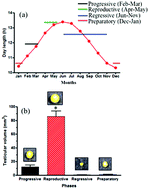当前位置:
X-MOL 学术
›
Photochem. Photobiol. Sci.
›
论文详情
Our official English website, www.x-mol.net, welcomes your feedback! (Note: you will need to create a separate account there.)
Photoperiodic control of GnRH-I expression in seasonal reproduction of the Eurasian tree sparrow
Photochemical & Photobiological Sciences ( IF 3.1 ) Pub Date : 2018-06-18 00:00:00 , DOI: 10.1039/c8pp00153g Anand S. Dixit 1, 2, 3 , Sanborlang Byrsat 1, 2, 3
Photochemical & Photobiological Sciences ( IF 3.1 ) Pub Date : 2018-06-18 00:00:00 , DOI: 10.1039/c8pp00153g Anand S. Dixit 1, 2, 3 , Sanborlang Byrsat 1, 2, 3
Affiliation

|
Day length has been shown to be a major source of temporal information regulating seasonal reproduction in the Eurasian tree sparrow (Passer montanus). The present study aims to investigate the photoperiodic expression of gonadotropin-releasing hormone-I (GnRH-I), and how it mediates seasonal reproduction in male tree sparrows. In different experiments, we studied photoperiod-induced changes in GnRH-I expressing neurons in the hypothalamic preoptic area (POA), together with changes in testicular size under both natural and artificial photoperiodic conditions. Experiment 1, which involved studying changes in GnRH-I expression and testicular volume during different phases of the annual reproductive cycle under natural day length (NDL), revealed that sparrows possess a definite seasonal cycle of GnRH-I peptide expression that runs parallel to testicular size. Birds showed significantly higher levels of GnRH-I expression in the breeding phase when compared to the non-breeding phase. In experiment 2, photosensitive birds were exposed to artificial short (SD: 9L/15D) and long (LD: 14L/10D) day lengths for 240 days to investigate the photoperiodic regulation of GnRH-I expression. They exhibited a significant increase followed by a decrease in GnRH-I expression and testicular size under LD but not SD, suggesting photoperiodic regulation. In experiment 3, when photosensitive birds were exposed to increasing photoperiods (9L/15D, 10L/14D, 10.5L/13.5D, 11L/13D, 12L/12D) for 30 days to find out the critical photoperiod for GnRH-I expression, they responded only when the daily photoperiod was 11 h or more. These results clearly indicate that tree sparrows are capable of fine discrimination of photoperiodic information and use day length for GnRH-I expression to control their seasonal reproduction.
中文翻译:

欧亚树麻雀的季节性繁殖中GnRH-I表达的光周期控制
事实表明,日长是调节欧亚树麻雀(Passer montanus)季节性繁殖的时间信息的主要来源)。本研究旨在调查促性腺激素释放激素-I(GnRH-I)的光周期表达,以及它如何介导雄性麻雀的季节性繁殖。在不同的实验中,我们研究了光周期诱导的下丘脑前视区(POA)中表达GnRH-1的神经元的变化,以及自然和人工光周期条件下睾丸大小的变化。实验1涉及研究自然天长(NDL)下年度生殖周期不同阶段GnRH-1的表达和睾丸体积的变化,该实验揭示了麻雀具有一定的GnRH-1肽表达的季节性周期,该周期与睾丸平行尺寸。与非繁殖阶段相比,鸟类在繁殖阶段表现出明显更高的GnRH-1表达水平。在实验2中,将光敏禽类暴露于人造短(SD:9L / 15D)和长(LD:14L / 10D)日长度下240天,以研究GnRH-1表达的光周期调节。它们表现出显着的增加,随后在LD而不是SD下GnRH-1表达和睾丸大小减少,表明光周期调节。在实验3中,当光敏禽类暴露在不断增加的光周期(9L / 15D,10L / 14D,10.5L / 13.5D,11L / 13D,12L / 12D)中30天以找出GnRH-1表达的关键光周期时,他们仅在每日光照周期为11小时或更长时间时才做出反应。这些结果清楚地表明,树麻雀能够很好地区分光周期信息,并且利用GnRH-1的表达天数来控制它们的季节性繁殖。将光敏禽类暴露于人造短(SD:9L / 15D)和长(LD:14L / 10D)天长度下240天,以研究GnRH-1表达的光周期调节。它们表现出显着的增加,随后在LD而不是SD下GnRH-1表达和睾丸大小减少,表明光周期调节。在实验3中,当光敏禽类暴露在不断增加的光周期(9L / 15D,10L / 14D,10.5L / 13.5D,11L / 13D,12L / 12D)中30天以找出GnRH-1表达的关键光周期时,他们仅在每日光照周期为11小时或更长时间时才做出反应。这些结果清楚地表明,树麻雀能够很好地区分光周期信息,并且利用GnRH-1的表达天数来控制它们的季节性繁殖。将光敏禽类暴露于人造短(SD:9L / 15D)和长(LD:14L / 10D)天长度下240天,以研究GnRH-1表达的光周期调节。它们表现出显着的增加,随后在LD而不是SD下GnRH-1表达和睾丸大小减少,表明光周期调节。在实验3中,当光敏禽类暴露在不断增加的光周期(9L / 15D,10L / 14D,10.5L / 13.5D,11L / 13D,12L / 12D)中30天以找出GnRH-1表达的关键光周期时,他们仅在每日光照周期为11小时或更长时间时才做出反应。这些结果清楚地表明,树麻雀能够很好地区分光周期信息,并且利用GnRH-1的表达天数来控制它们的季节性繁殖。14天/ 10天)的时间长度为240天,以研究GnRH-1表达的光周期调节。它们表现出显着的增加,随后在LD而不是SD下GnRH-1表达和睾丸大小减少,表明光周期调节。在实验3中,当光敏禽类暴露在不断增加的光周期(9L / 15D,10L / 14D,10.5L / 13.5D,11L / 13D,12L / 12D)中30天以找出GnRH-1表达的关键光周期时,他们仅在每日光照周期为11小时或更长时间时才做出反应。这些结果清楚地表明,树麻雀能够很好地区分光周期信息,并且利用GnRH-1的表达天数来控制它们的季节性繁殖。14天/ 10天)的时间长度为240天,以研究GnRH-1表达的光周期调节。它们表现出显着的增加,随后在LD而不是SD下GnRH-1表达和睾丸大小减少,表明光周期调节。在实验3中,当光敏禽类暴露在不断增加的光周期(9L / 15D,10L / 14D,10.5L / 13.5D,11L / 13D,12L / 12D)中30天以找出GnRH-1表达的关键光周期时,他们仅在每日光照周期为11小时或更长时间时才做出反应。这些结果清楚地表明,树麻雀能够很好地区分光周期信息,并且利用GnRH-1的表达天数来控制它们的季节性繁殖。它们表现出显着的增加,随后在LD而不是SD下GnRH-1表达和睾丸大小减少,表明光周期调节。在实验3中,当光敏禽类暴露在不断增加的光周期(9L / 15D,10L / 14D,10.5L / 13.5D,11L / 13D,12L / 12D)中30天以找出GnRH-1表达的关键光周期时,他们仅在每日光照周期为11小时或更长时间时才做出反应。这些结果清楚地表明,树麻雀能够很好地区分光周期信息,并且利用GnRH-1的表达天数来控制它们的季节性繁殖。它们表现出显着的增加,随后在LD而不是SD下GnRH-1表达和睾丸大小减少,表明光周期调节。在实验3中,当光敏禽类暴露在不断增加的光周期(9L / 15D,10L / 14D,10.5L / 13.5D,11L / 13D,12L / 12D)中30天以找出GnRH-1表达的关键光周期时,他们仅在每日光照周期为11小时或更长时间时才做出反应。这些结果清楚地表明,树麻雀能够很好地区分光周期信息,并且利用GnRH-1的表达天数来控制它们的季节性繁殖。12L / 12D)持续30天以找出GnRH-1表达的关键光周期,只有当每日光周期为11 h或更长时,他们才会做出反应。这些结果清楚地表明,树麻雀能够很好地区分光周期信息,并且利用GnRH-1的表达天数来控制它们的季节性繁殖。12L / 12D)持续30天以找出GnRH-1表达的关键光周期,只有当每日光周期为11 h或更长时,他们才会做出反应。这些结果清楚地表明,树麻雀能够很好地区分光周期信息,并且利用GnRH-1的表达天数来控制它们的季节性繁殖。
更新日期:2018-06-18
中文翻译:

欧亚树麻雀的季节性繁殖中GnRH-I表达的光周期控制
事实表明,日长是调节欧亚树麻雀(Passer montanus)季节性繁殖的时间信息的主要来源)。本研究旨在调查促性腺激素释放激素-I(GnRH-I)的光周期表达,以及它如何介导雄性麻雀的季节性繁殖。在不同的实验中,我们研究了光周期诱导的下丘脑前视区(POA)中表达GnRH-1的神经元的变化,以及自然和人工光周期条件下睾丸大小的变化。实验1涉及研究自然天长(NDL)下年度生殖周期不同阶段GnRH-1的表达和睾丸体积的变化,该实验揭示了麻雀具有一定的GnRH-1肽表达的季节性周期,该周期与睾丸平行尺寸。与非繁殖阶段相比,鸟类在繁殖阶段表现出明显更高的GnRH-1表达水平。在实验2中,将光敏禽类暴露于人造短(SD:9L / 15D)和长(LD:14L / 10D)日长度下240天,以研究GnRH-1表达的光周期调节。它们表现出显着的增加,随后在LD而不是SD下GnRH-1表达和睾丸大小减少,表明光周期调节。在实验3中,当光敏禽类暴露在不断增加的光周期(9L / 15D,10L / 14D,10.5L / 13.5D,11L / 13D,12L / 12D)中30天以找出GnRH-1表达的关键光周期时,他们仅在每日光照周期为11小时或更长时间时才做出反应。这些结果清楚地表明,树麻雀能够很好地区分光周期信息,并且利用GnRH-1的表达天数来控制它们的季节性繁殖。将光敏禽类暴露于人造短(SD:9L / 15D)和长(LD:14L / 10D)天长度下240天,以研究GnRH-1表达的光周期调节。它们表现出显着的增加,随后在LD而不是SD下GnRH-1表达和睾丸大小减少,表明光周期调节。在实验3中,当光敏禽类暴露在不断增加的光周期(9L / 15D,10L / 14D,10.5L / 13.5D,11L / 13D,12L / 12D)中30天以找出GnRH-1表达的关键光周期时,他们仅在每日光照周期为11小时或更长时间时才做出反应。这些结果清楚地表明,树麻雀能够很好地区分光周期信息,并且利用GnRH-1的表达天数来控制它们的季节性繁殖。将光敏禽类暴露于人造短(SD:9L / 15D)和长(LD:14L / 10D)天长度下240天,以研究GnRH-1表达的光周期调节。它们表现出显着的增加,随后在LD而不是SD下GnRH-1表达和睾丸大小减少,表明光周期调节。在实验3中,当光敏禽类暴露在不断增加的光周期(9L / 15D,10L / 14D,10.5L / 13.5D,11L / 13D,12L / 12D)中30天以找出GnRH-1表达的关键光周期时,他们仅在每日光照周期为11小时或更长时间时才做出反应。这些结果清楚地表明,树麻雀能够很好地区分光周期信息,并且利用GnRH-1的表达天数来控制它们的季节性繁殖。14天/ 10天)的时间长度为240天,以研究GnRH-1表达的光周期调节。它们表现出显着的增加,随后在LD而不是SD下GnRH-1表达和睾丸大小减少,表明光周期调节。在实验3中,当光敏禽类暴露在不断增加的光周期(9L / 15D,10L / 14D,10.5L / 13.5D,11L / 13D,12L / 12D)中30天以找出GnRH-1表达的关键光周期时,他们仅在每日光照周期为11小时或更长时间时才做出反应。这些结果清楚地表明,树麻雀能够很好地区分光周期信息,并且利用GnRH-1的表达天数来控制它们的季节性繁殖。14天/ 10天)的时间长度为240天,以研究GnRH-1表达的光周期调节。它们表现出显着的增加,随后在LD而不是SD下GnRH-1表达和睾丸大小减少,表明光周期调节。在实验3中,当光敏禽类暴露在不断增加的光周期(9L / 15D,10L / 14D,10.5L / 13.5D,11L / 13D,12L / 12D)中30天以找出GnRH-1表达的关键光周期时,他们仅在每日光照周期为11小时或更长时间时才做出反应。这些结果清楚地表明,树麻雀能够很好地区分光周期信息,并且利用GnRH-1的表达天数来控制它们的季节性繁殖。它们表现出显着的增加,随后在LD而不是SD下GnRH-1表达和睾丸大小减少,表明光周期调节。在实验3中,当光敏禽类暴露在不断增加的光周期(9L / 15D,10L / 14D,10.5L / 13.5D,11L / 13D,12L / 12D)中30天以找出GnRH-1表达的关键光周期时,他们仅在每日光照周期为11小时或更长时间时才做出反应。这些结果清楚地表明,树麻雀能够很好地区分光周期信息,并且利用GnRH-1的表达天数来控制它们的季节性繁殖。它们表现出显着的增加,随后在LD而不是SD下GnRH-1表达和睾丸大小减少,表明光周期调节。在实验3中,当光敏禽类暴露在不断增加的光周期(9L / 15D,10L / 14D,10.5L / 13.5D,11L / 13D,12L / 12D)中30天以找出GnRH-1表达的关键光周期时,他们仅在每日光照周期为11小时或更长时间时才做出反应。这些结果清楚地表明,树麻雀能够很好地区分光周期信息,并且利用GnRH-1的表达天数来控制它们的季节性繁殖。12L / 12D)持续30天以找出GnRH-1表达的关键光周期,只有当每日光周期为11 h或更长时,他们才会做出反应。这些结果清楚地表明,树麻雀能够很好地区分光周期信息,并且利用GnRH-1的表达天数来控制它们的季节性繁殖。12L / 12D)持续30天以找出GnRH-1表达的关键光周期,只有当每日光周期为11 h或更长时,他们才会做出反应。这些结果清楚地表明,树麻雀能够很好地区分光周期信息,并且利用GnRH-1的表达天数来控制它们的季节性繁殖。


























 京公网安备 11010802027423号
京公网安备 11010802027423号